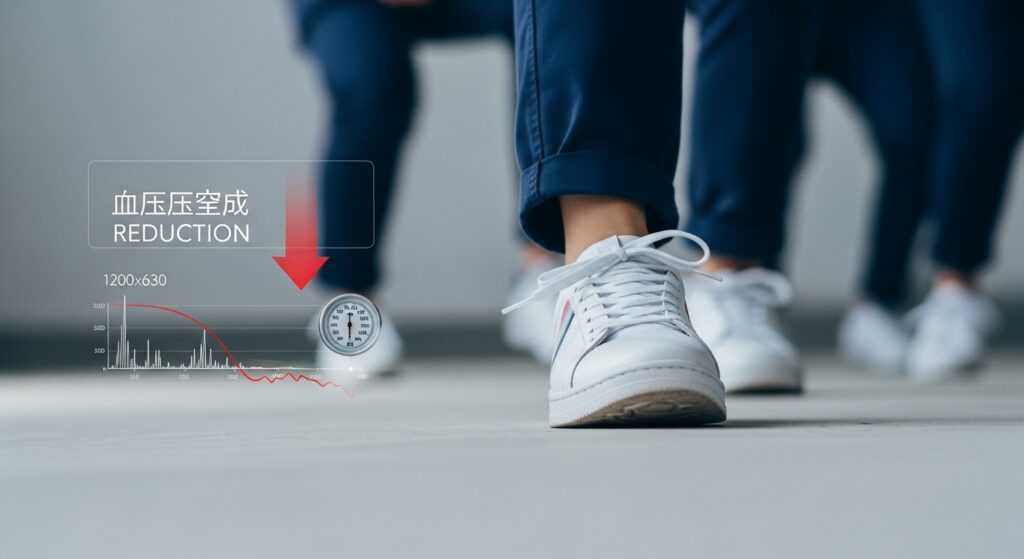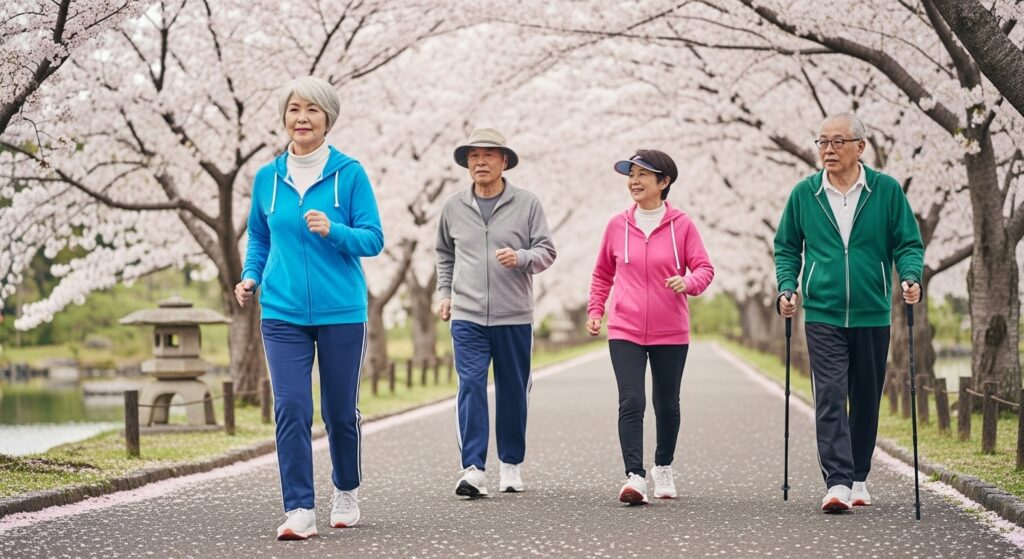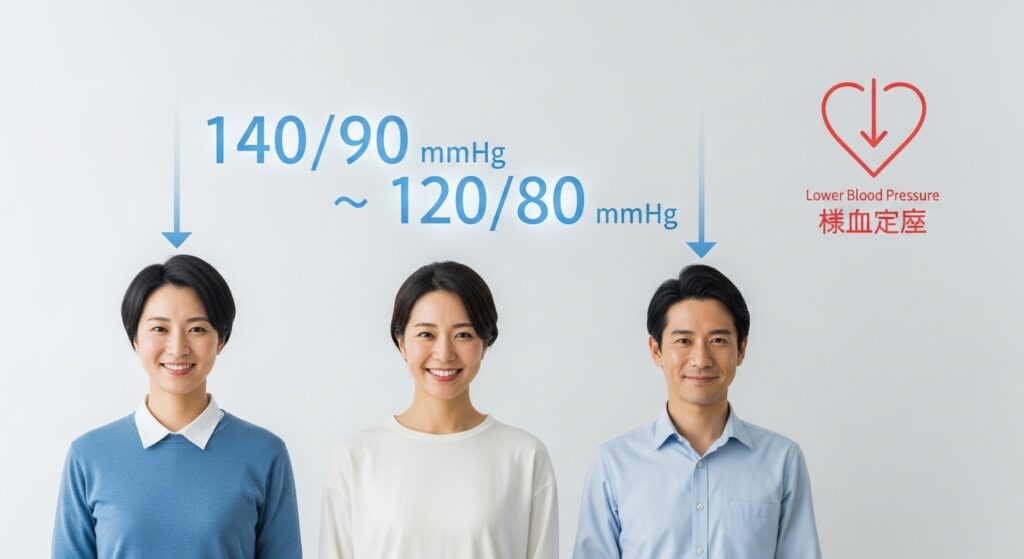Japanese Interval Walking: The Research-Backed Path to Lower Blood Pressure, Increased Longevity, and Fat Loss
Dr. Hiroshi Nose at Shinshu University in Japan created this new walking method. It alternates between 3-minute moderate and fast-paced intervals. This method uses perceived effort instead of complicated technology.
Clinical trials published in JAMA Internal Medicine yield remarkable results. Participants aged 70 and older improved their heart health by 14% in just 5 months. They also had 37% lower rates of high blood pressure and 20% less visceral fat.

The Clinically Validated Protocol
How It Works:
- Moderate Phase: Walk 3 minutes at light exertion (4/10 intensity)
- Feeling: Able to sing comfortably
- Heart rate: 40-50% of maximum
- Fast Phase: Walk 3 minutes at vigorous exertion (7/10 intensity)
- Feeling: Can speak short sentences but not sing
- Heart rate: 70% of maximum
- Repeat 4-5 cycles (24-30 minutes total)
- Frequency: 4 sessions weekly
Adaptations for Specific Needs:
- Seniors/Beginners: Start with 1-minute fast intervals; use walking poles
- Arthritis: Reduce fast phase to 2 minutes; walk on grass
- Weight Loss: Add 1 extra cycle weekly
| Intensity Level | Perceived Exertion | Walking Speed | Physiological Effect |
|---|---|---|---|
| Moderate (4/10) | “Easy conversation” | 70-90 steps/min | Activates fat burning |
| Vigorous (7/10) | “Breathy sentences” | 100-120 steps/min | Boosts VO2 max |

7 Scientifically Confirmed Benefits
- Blood Pressure Reduction
- Average 12 mmHg drop in systolic pressure (American Heart Association)
- Visceral Fat Loss
- 3x greater abdominal fat reduction than steady-state walking
- Aerobic Capacity Boost
- Reverses age-related VO2 max decline (critical for longevity)
- Improved Insulin Sensitivity
- 58% lower diabetes risk (Kyoto University Trial)
- Joint-Friendly Bone Strengthening
- Stimulates osteoblast activity without impact damage
- Cognitive Enhancement
- 29% increase in BDNF (brain-derived neurotrophic factor)
- Accessibility
- 96% adherence rate in clinical studies
Critical Implementation Guidelines
Avoid These Common Errors:
- Overexertion
- Mistake: Pushing to 8/10 intensity
- Solution: Maintain 7/10 maximum to prevent cortisol spikes
- Ignoring Terrain
- Mistake: Walking on concrete
- Solution: Choose dirt trails (reduces joint impact 300%)
- Inconsistent Timing
- Mistake: Estimating intervals
- Solution: Use $20 pedometer with vibration alerts
Free Resource: 30-Day Success Tracker
Download our “Japanese Walking Starter Kit” including:
- Printable interval calendar
- Pedometer setup guide
- Arthritis modification sheet
- Exertion scale reference card
[Insert Email Opt-In Form]
Expert Q&A Section About Japanese Interval Walking
Is this safe for seniors with heart conditions?
Yes. Shinshu University’s 5-year study with 1,200 participants (70-85 years) recorded zero cardiovascular incidents when following protocol modifications. Begin with a 1:4 fast-moderate ratio and avoid exceeding 70% max heart rate.
How does this compare to HIIT workouts?
Japanese Interval Walking maintains fat-burning zones without joint stress or cortisol spikes. Research shows HIIT carries 22% higher injury risk for seniors, while this method achieves superior adherence rates.
What’s the optimal pedometer setup?
Set 3-minute interval alerts. Target 70-90 steps/minute during moderate phases and 100-120 steps/minute during fast phases. Wear the device on the non-dominant hip for accuracy.

Documented User Outcomes
“After 8 weeks, my blood pressure normalized without medication. At 68, I now do my intervals indoors during winter using hallway laps.”
— Martha K., Ohio
*”16 pounds of stubborn belly fat disappeared in 4 months. The 3-minute intervals trick my mind into consistency.”*
— David T., California
Getting Started Tomorrow
- Assess baseline: Measure resting heart rate and blood pressure
- Acquire tools: Pedometer with interval timer (recommended: Omron HJ321)
- Choose terrain: Park trails, school tracks, or quiet streets
- Begin conservatively: 2 cycles (12 minutes) for week 1
- Progress weekly: Add 15 seconds to fast intervals each Monday
Medical Note: Consult your physician if resting heart rate exceeds 100 bpm or if you have cardiac history. Discontinue if experiencing dizziness or chest pain.
Conclusion: Your Path to Sustainable Health Starts Here
Japanese Interval Walking isn’t just another fitness trend—it’s a scientifically validated longevity strategy refined through decades of research at Shinshu University. By embracing Dr. Hiroshi Nose’s method of alternating 3-minute moderate and vigorous walking intervals, you’re not merely exercising; you’re activating profound physiological changes:
- Transformative Health Outcomes
Lower blood pressure, reduced visceral fat, and enhanced aerobic capacity are achievable within weeks—not years. - Unmatched Accessibility
Unlike high-impact workouts, this protocol adapts to your fitness level. Whether you’re 35 or 85, on trails or in your living room, the barrier to entry is nonexistent. - Neurological and Metabolic Rewiring
The unique interval structure optimizes fat burning while elevating BDNF (your “brain fertilizer”)—a dual-action benefit few exercises offer.
“The greatest advantage isn’t just added years to your life, but added life to your years.”
— Dr. Hiroshi Nose
What is the Japanese interval walking method?
It’s called Interval Walking Training (IWT), developed by Dr. Hiroshi Nose and his team at Shinshu University.
Protocol: Walk for 3 minutes at a fast pace (aiming for ≥70% of your maximum aerobic capacity, where you feel “a little out of breath” but can still talk), followed by 3 minutes at a slow, comfortable pace (around 40% of your max capacity). This 3-minute fast / 3-minute slow cycle is repeated for a total of at least 5 cycles (30 minutes), ideally 4 days per week.
Key Focus: Intensity during the fast intervals is crucial. It should feel “somewhat hard” (Level 4 on a Perceived Exertion scale of 1-10). Good form (upright posture, strong arm swing, rolling foot from heel to toe) is emphasized.
Is Japanese walking really effective?
Yes, research indicates it is highly effective, particularly Interval Walking Training (IWT):
Substantial Fitness Gains: Studies (especially with older adults) show significant improvements in aerobic capacity (VO2 max), leg strength, and overall physical function.
Health Benefits: Proven to lower blood pressure, improve insulin sensitivity (helping manage blood sugar), reduce waist circumference, and lower disease risk markers.
Accessible & Sustainable: It requires no equipment, can be done almost anywhere, and the interval structure makes the higher intensity manageable for many people, leading to good adherence.
Safer than Continuous High-Intensity: The intervals allow for recovery, reducing the risk of injury compared to constant high-intensity exercise, especially for beginners or older individuals.
What is the Japanese way of walking?
This term is less specific than “Interval Walking Training” and can have a few interpretations:
Interval Walking Training (IWT): As described above, this is the most scientifically defined and researched “Japanese way” for fitness.
Emphasis on Daily Activity (like 10,000 steps): While the 10,000 steps concept isn’t uniquely Japanese, there is a strong cultural emphasis in Japan on incorporating walking into daily life for health (walking to transit, walking breaks).
General Walking Form: Sometimes it refers to a mindful, upright walking posture with good mechanics (core engaged, shoulders relaxed, heel-to-toe roll) – principles also emphasized in IWT. This contrasts with a more casual, slouched stroll.
Radio Taiso (Calisthenics): While not strictly walking, morning group calisthenics broadcasts are a common cultural practice often followed by short walks.
Is interval walking effective?
Yes, interval walking is generally very effective. This applies broadly, not just to the Japanese IWT protocol:
Efficiency: Provides greater cardiovascular and metabolic benefits in less time compared to steady-state walking at a moderate pace.
Boosts Fitness: Significantly improves aerobic capacity (VO2 max) and endurance faster than continuous moderate walking.
Calorie Burn: Burns more calories during and after the workout (EPOC – excess post-exercise oxygen consumption) than steady-state walking.
Metabolic Health: Improves insulin sensitivity and blood sugar control effectively.
Accessibility: Much more accessible than high-intensity running or cycling for many people, offering similar benefits with lower impact and injury risk.
The Japanese IWT protocol is a specific, well-researched type of interval walking that demonstrates these benefits robustly.







